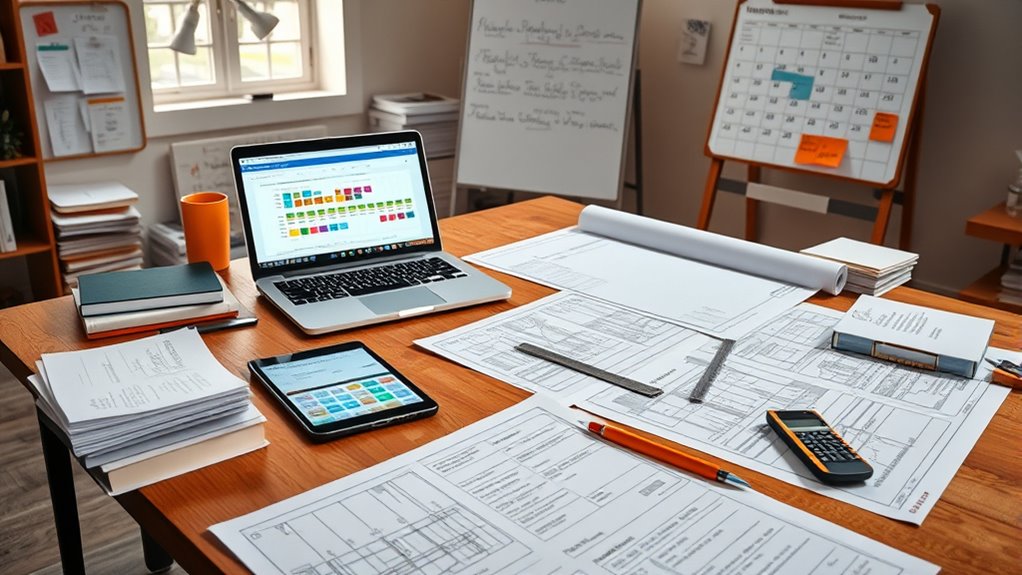To successfully plan your home project, start by clearly defining your goals and priorities, such as creating more space or updating the look. Set a realistic budget and timeline, including contingencies for surprises. Choose durable materials and find trusted professionals with good reviews. Organize your plan with milestones and secure all necessary permits. Regularly monitor progress to stay on track, and you’ll build confidence as you move forward — there’s more to discover to make your project a success.
Key Takeaways
- Define clear goals and priorities, visualizing the final space to guide decision-making.
- Develop a realistic budget and timeline, including contingency funds and phased milestones.
- Select durable materials and hire licensed professionals with good references for safety and quality.
- Secure all necessary permits and create a detailed plan aligned with project milestones.
- Regularly monitor progress, adjust plans as needed, and track expenses to ensure project success.
Defining Your Project Goals and Priorities

Before diving into the details of your home project, it’s essential to clearly define your goals and priorities. Creative visualization helps you picture the finished space, making your objectives concrete and inspiring. Think about what you truly want—more space, better functionality, or a fresh look—and prioritize these needs. Engaging stakeholders, like family members or future users, ensures everyone’s input is considered, aligning expectations from the start. This clarity guides your decision-making and keeps the project focused. Additionally, understanding the importance of nutrients in your overall well-being can influence your choices in creating a healthier living environment. By visualizing your ideal outcome and involving key people early on, you set a strong foundation for success. Clear goals and priorities not only streamline the planning process but also help you stay committed throughout the journey.
Developing a Realistic Budget and Timeline

Creating a realistic budget and timeline is essential for keeping your home project on track and avoiding costly surprises. To do this, start with accurate cost estimation by researching prices for materials, labor, and permits. Then, develop a detailed timeline management plan that considers each phase of the project and possible delays. Keep these tips in mind:
- Break down your project into manageable steps with specific deadlines
- Add contingency funds for unexpected expenses
- Regularly track progress against your timeline
- Adjust your budget and schedule as needed based on ongoing estimates
Selecting Materials and Finding Trusted Professionals

Choosing the right materials and trusted professionals is essential for guaranteeing your home project’s success. When selecting materials, prioritize material durability to ensure longevity and reduce future costs. High-quality materials might cost more upfront but save you money over time by lasting longer. Equally important is finding professionals with proper contractor licensing; licensed contractors adhere to safety standards and legal requirements, giving you peace of mind. Do your research: read reviews, ask for references, and verify credentials before hiring. Trustworthy professionals will help you make informed decisions about materials and ensure your project is completed efficiently and to code. Taking the time to select durable materials and reliable experts sets the foundation for a successful, stress-free home improvement.
Organizing Your Project Plan and Permits

Once you’ve selected your materials and hired trusted professionals, the next step is to organize your project plan and secure the necessary permits. Understanding permit requirements helps you stay compliant and avoid delays. Break down your plan into clear project milestones to track progress efficiently. Incorporating environmental innovations such as sustainable building practices can also enhance your project’s long-term viability.
Monitoring Progress and Adjusting as Needed

Monitoring your progress regularly is essential to guarantee your project stays on track and any issues are addressed promptly. Consistent progress tracking helps you spot delays or overspending early, allowing quick adjustments. If unexpected problems arise, contingency planning ensures you’re prepared to adapt without derailing your timeline or budget. Use tools like checklists, schedules, or software to stay organized. Regularly review your milestones and compare them against actual progress. If you notice deviations, revise your plan accordingly. Additionally, understanding regional resources can help you access local expertise and support when needed. Here’s a simple way to visualize your progress and contingency options:
| Progress Tracking Ideas | Contingency Planning Strategies |
|---|---|
| Weekly check-ins | Budget buffers |
| Milestone reviews | Alternative suppliers |
| Update schedules | Flexible work timelines |
| Track expenses | Emergency funding options |
Stay proactive; adjusting early keeps your project smooth.
Frequently Asked Questions
How Do I Handle Unexpected Issues During the Project?
When unexpected issues pop up during your project, stay calm and assess the situation quickly. Use contingency planning to identify potential problems beforehand and have backup plans ready. Practice emergency preparedness by keeping essential tools and contacts accessible. Communicate openly with your team or contractors to find solutions fast. Flexibility and proactive measures help you navigate surprises smoothly, keeping your project on track and reducing stress.
What Are Common Mistakes to Avoid in Home Projects?
You should avoid common mistakes like poor budget planning and rushed material selection. Always set a realistic budget and stick to it, including a contingency fund for unexpected costs. Take your time choosing quality materials that fit your project’s needs, rather than opting for the cheapest options. Careful planning prevents costly errors, keeps your project on track, and ensures you’re satisfied with the final result.
How Can I Ensure Safety Throughout the Project?
Did you know that 25% of home project injuries happen due to overlooked safety precautions? To stay safe, always wear the right safety gear, like goggles and gloves, and keep your workspace organized. Have emergency plans in place, such as accessible first aid kits and clear exits. Stay alert, follow instructions carefully, and don’t rush—these steps will help protect you throughout your project.
What Permits Are Typically Required for Home Renovations?
You’ll typically need permit requirements for major home renovations like additions, electrical work, or plumbing updates. Check with your local building department to understand the necessary renovation approvals; they might require detailed plans or inspections. Failing to obtain permits can lead to fines or delays, so always make sure you secure the proper permits before starting. This proactive step helps keep your project legal, safe, and on track.
How Do I Choose the Right Professionals for My Project?
Choosing the right professionals is as vital as finding a needle in a haystack, so don’t rush it! Start with contractor selection by checking reviews, credentials, and experience. Meet with potential candidates, ask about their past projects, and compare quotes. Keep your budget planning in mind to make certain their services fit your financial plan. Trust your instincts and select someone who communicates clearly and shows genuine enthusiasm for your project.
Conclusion
Now that you know the essentials of planning your home project, you’re ready to start confidently. Remember, careful planning and flexibility keep everything on track. Will you let surprises derail your progress, or will you adapt and thrive? By staying organized and proactive, you can turn your vision into reality without unnecessary stress. Trust yourself—you’ve got this, and the results will be worth every effort.










